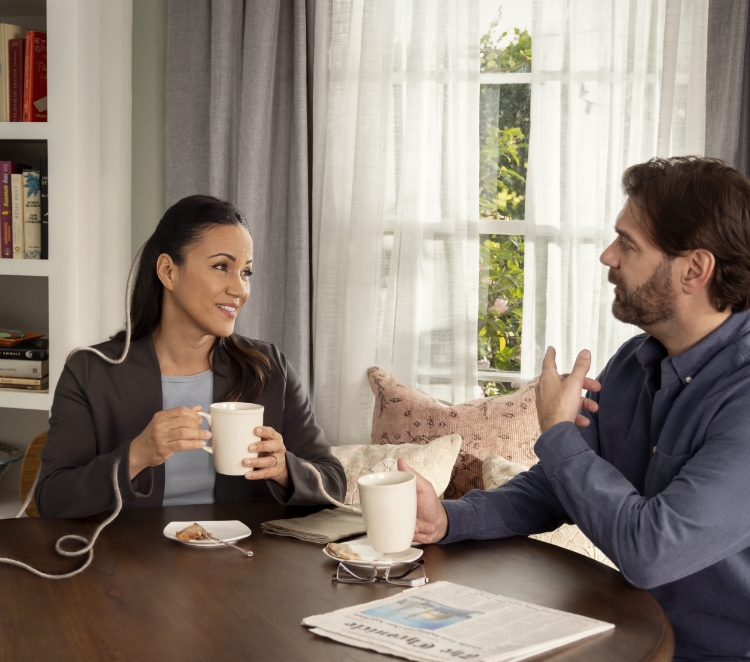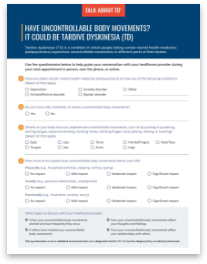Support for Tardive Dyskinesia (TD) | TalkAboutTD (original) (raw)

Actor portrayals
The right support could make a real difference to a loved one struggling with uncontrollable body movements
You may not have tardive dyskinesia (TD), but you might know someone who does.
Caring for someone with TD can be challenging. It may be up to you to help identify symptoms and assist in managing their condition.
Sometimes people with TD may not realize they are having uncontrollable body movements or they may not be ready to talk about it. However, with your positive influence, you can help create on-going conversations.
Care Partner Support Tips
Know what TD looks like and how to recognize it
Mild, moderate, or severe uncontrollable body movements can occur in one or more spots in the body. They are often seen in the face, torso, limbs, and fingers or toes.
Educate yourself on the cause and impact of TD
TD is associated with taking certain mental health medicines (antipsychotics) to treat conditions like depression, bipolar disorder, schizoaffective disorder, or anxiety disorder. TD can develop after a few months or years of treatment on mental health medicines.
Encourage them to talk to their healthcare provider
If you think someone in your life may have TD, ask them if they would consider talking to their healthcare provider about TD or related movement disorders.
Keep an eye out for signs and symptoms of TD
If someone you know is experiencing uncontrollable body movements, they may not be aware of these movements. You can help them learn to recognize the condition and get the help they need to manage their TD.
You may notice uncontrollable body movements they don’t


Actor portrayals
If someone you care about begins moving in ways you don’t recognize, they may not even be aware of these uncontrollable body movements. And they may not know that help is available.
It’s OK to speak up—if you think someone you care about may have uncontrollable body movements, encourage them to talk to their healthcare provider about TD. Also, consider asking them to record their movements so they can share them with their provider during an in-person or telemedicine appointment.

April was compensated by Neurocrine Biosciences, Inc. to share her story
“My sister noticed that my bottom lip was moving to one side. She asked if any of my medications caused TD.”
–APRIL
LIVING WITH MAJOR
DEPRESSIVE DISORDER
AND TARDIVE DYSKINESIA

Actor portrayals
Care partners need support, too
It can be challenging for everyone involved when someone is diagnosed with TD.
Research shows that care partners often neglect their own health due to the challenge of caring for others. Make sure you’re taking care of yourself as it can help you take care of others.
Activities that may help relieve stress:
- Getting plenty of sleep every night
- Maintaining a balanced, nutritious diet
- Exercising regularly


Actor portrayal
Discover helpful resources, including organizations that support TD and mental health. Many advocacy groups have specific resources for care partners.

You can use the Doctor Discussion Guide to get helpful info on how to have a productive in-person or telemedicine appointment.
Looking to take the first step in managing your uncontrollable body movements? Talk to a specialist.
Find psychiatrists, neurologists, and other advanced-practice healthcare providers experienced with diagnosing and treating TD. Talk about your uncontrollable body movements with them and learn about treatments that could help you manage TD.